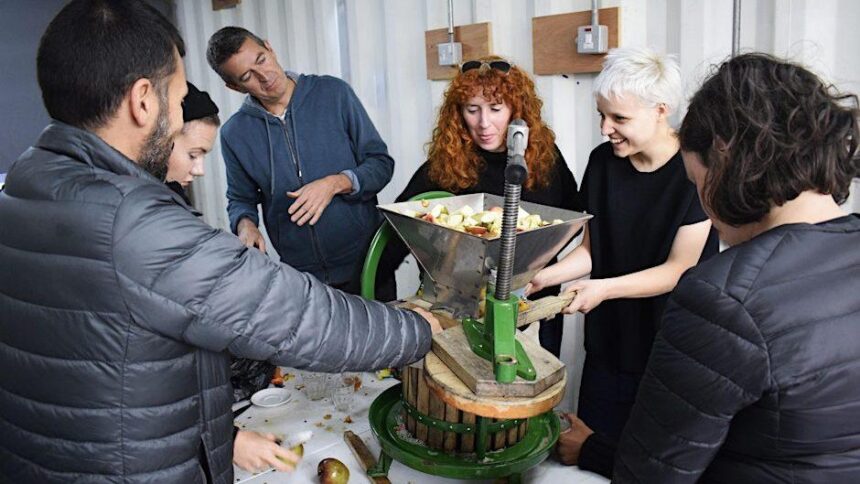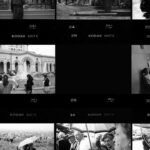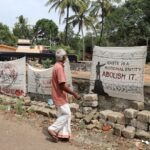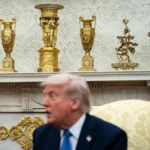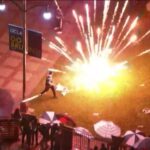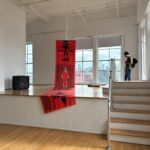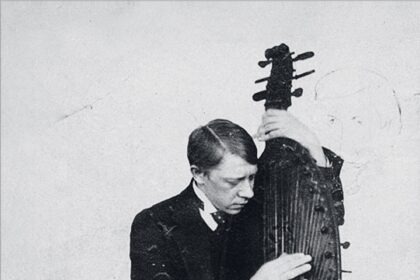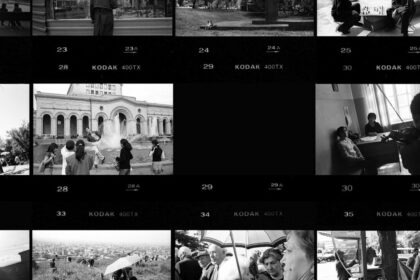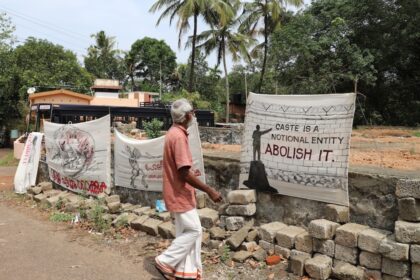Authoritarian Drift: Field Report on the UK-2025
Isabel Lima and Kim Charnley
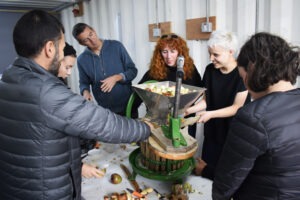
The well-springs of democracy are spaces of encounter: the agora, the town square, the public meeting place where shared problems are confronted, discussed, argued through. Capitalist democracy at the scale of the nation-state is something else entirely. The UK likes to promote itself as a ‘birthplace’ of the parliamentary democratic system, but its government treats democratic rights with intense suspicion. Spaces that allow for community to emerge are commodified and privatized, and the dialogue and collective action intended to reclaim control over a shared future is suppressed. Even a government nominally of the left, such as the current Labour administration in the UK, enacts authoritarian legislation suppressing rights to protest and free speech. How do socially engaged artists keep hold of the practical meaning of their work in these conditions?
Theories of democracy have greatly enriched debates about socially engaged art, but at a practical level democracy exists as a capacity to resist state oppression. This capacity can be built and maintained in many ways, but it thrives when it is anchored in networks that are able to assert their autonomy. There are many famous examples of places that have demonstrated this capacity, bordering on an autonomous zone, such as Exarchia in Athens, a neighborhood with a long history of resistance to police violence. In the UK, a comparable reserve of practical democracy exists in a city like Bristol, which came to global attention during the BLM protests of 2020, when the statue to slave trader Edward Colston was removed. Bristol was also at the forefront of protests against authoritarian legislation enacted by the Conservative government in the ‘Police, Crime Sentencing and Courts act’ of 2022; and popular resistance against the anti-migrant riots instigated by the far-right in 2024.
Many other parts of the UK demonstrate their democratic capacity too, for example, where communities turn out en masse to prevent the deportation of migrants, most famously in Kenmure street in Glasgow in 2021, when immigration officials were compelled to release two men from custody because their van was completely surrounded by protesting crowds. But solidarity with people who are subject to violent border regimes is sadly not the norm. Both Labour and Conservative governments amplified xenophobic talking points as ‘legitimate concerns’, and online far-right agitation ensures that migrants are the scapegoat for discontent with declining standards of living. The far-right riots of August 2024 in the UK and, in Northern Ireland in 2025, all targeted hotels thought to be sheltering asylum-seekers and both riots were used as an opportunity to terrorize minority groups, regardless of their citizenship status.
Meanwhile, rights to freedom of expression, assembly and association are further dismantled through the implementation of legislation such as the Public Order Act 2023.[1] This act was prompted by high-profile protests by environmental groups like Extinction Rebellion and Just Stop Oil, introducing new criminal offenses that greatly expand police powers to suppress protest. According to Stop-Watch, the first arrests under this Act for the offence of “locking-on” involved a group of Palestine Action protesters on 1 November 2023, after they chained themselves together at the entrance of Israeli arms company, Elbit’s HQ.
Palestine Action is a pro-Palestinian organization which attempts to disrupt the arms industry in the United Kingdom through direct action against British factories run by Israeli weapons manufacturer Elbit Systems, as well other companies that support the production of arms and munitions used against Palestinians. It has been reported that Labour approved £10.9m in arms exports to Israel during its first three months in office in 2024.[2] Government ministers have made token criticisms of Israel (perhaps with an eye on the eventual legal reckoning for well-documented war crimes and genocidal statements by members of the Israeli government), but calls to end military support have been ignored.
As of 5 July 2025, Palestine Action has been proscribed as a terrorist organization in the UK. Under the UK’s Terrorism Act 2000, it is now an offense to be a member of, fundraise for, or even express an opinion or belief supportive of Palestine Action. As UN experts and human rights organisations have noted, it is a clear example of legal over-reach for anti-terror legislation to be used to proscribe an organization that has only ever employed direct action against property, with the stated intention of preventing the loss of life. As we write, over a hundred protestors have been arrested for ‘‘terrorism offenses” simply for holding banners making reference to Palestine Action. There are also cases where this proscription being used by police to interpret public display of Palestinian flags, or signs criticizing Israel for engaging in genocide, as giving reason for suspect that someone supports a terrorist organization.
Creative direct action is not used exclusively by artists, but it has been a key point of connection between activist art and social movements for decades, as part of the alterglobalization movement, Occupy and environmental movements. There is now a sustained legislative effort in the UK to criminalize strategies that have been highly effective in relation to anti-capitalist, environmental and humanitarian causes. The chilling effect on the arts extends also to other kinds of free speech. A veiled threat was issued in 2024 by the funding body Arts Council England (ACE) to National Portfolio Organizations (NPOs) to be “mindful” of “overly political and activist statements” professed by their workers or associates whether in a professional or private capacity. Failure to do so could place organisations at risk of losing funding under ACE’s reputational risk guidance. By “political statements”, ACE referred to expressions of support for a ceasefire in Palestine and speaking out against the ongoing genocide in Gaza. A Freedom of Information request revealed that ACE had discussed the Gaza conflict with the Department for Culture, Media and Sport (DCMS) one month prior to releasing this directive.
This directive was retracted shortly after due to public backlash, but it exposed the extent to which mechanisms of control filter through the state, linked always to funding, attempting to pressure individuals to inaction and subservience. Similar efforts have been made to silence musicians who have responded to urgent moral and political questions of this moment. The Irish rap trio Kneecap faced unlawful funding blocks and censorship when the BBC refused to broadcast their Glastonbury 2025 set live because of their criticism of Israel and support for the Palestinian cause. Similarly, Bob Vylan’s performance, which included chants against the Israeli Defense Forces, led the BBC, after government pressure, to stop live-broadcasting or live-streaming acts deemed “high risk”.
What is revealed by these examples of legislation imposed to control an intensely politicized cultural field? They indicate that the ideological hegemony of liberal democracy, as it weakens, loses its knack of burying contradictions. Where once liberal regimes were famous for their ability to neutralize dissent, either with rewards or token gestures, they now employ coercive state power. Artists are in a more exposed position as a result. Compounding the problem is increasing institutional instability, driven by austerity measures. Rumors have surfaced about the possible dismantling of DCMS which manages arts funding in the UK, with its responsibilities potentially being split between the Treasury, Education, and Business departments. Such fragmentation further weakens the infrastructure that supports cultural production, making it more difficult to mount unified responses to political or economic threats.
The political economy of the UK art world (and the art world more generally) has always been shaped by a policy of artificial scarcity, but this is currently intensified in the UK by an intensifying austerity agenda. Budgets are cut, institutional support is withdrawn, and funding opportunities are narrowly targeted. This scarcity serves not only economic efficiency but also ideological control. With fewer resources available, notions of fairness and justice become divisive rather than expansive. Artists and organizations are pitted against one another in a zero-sum logic of survival when applying for grants from ACE. Decisions about which projects receive funding become proxies for political positions, with questions like “Why them, not us?” that displace more systemic critiques that have played an important role in socially engaged art over the last two decades.[3]
Funding calls are increasingly compartmentalized, isolating and restricting expansive forms of social practice into narrow thematic silos such as environment, mental health, or migration. In pursuit of funding, artists are often required to tailor their work to current policy priorities, thereby shaping a restricted account, or cultural image of social justice. Although this dynamic is not new, the current moment demands critical self-reflection from practitioners. Socially engaged art has always been a risk of being used as a tool of managerial social ‘inclusion’, service delivery that concocts a deceitful aesthetic of social harmony, rather than critical solidarity. It is increasingly clear how economic and ideological pressures combine to encourage this anaemic mimicry of grassroots democracy. Artists will have to get even better at detecting and resisting the micro-physics of co-option, distinguishing between performative engagement and collective transformation, and holding the line around questions of free speech. The recent initiative by Massive Attack, Kneecap and Brian Eno to collectively resist the lawfare used in attempts to silence them, and to support musicians who are at a vulnerable early stage in their careers, provides a model. That is the way to stay true to the democratic potential of culture.
The mobilization of the far right is supported, directly or indirectly, by the very institutions that are supposed to preserve liberal democracy: the legal system, the mass media, and parliament. Lawfare is funded by right-wing networks with deep pockets. The media has pushed xenophobic narratives for decades, which are then reproduced in opinion polls, and focus groups, and picked up by politicians to demonstrate that they are ‘listening’ to popular concerns. Far-right influencers are the outriders of these narratives, spelling out their racist implications and seeking opportunities to generate conflict that normalizes attacks against minorities. Governments of left and right either follow the script for fear of negative coverage, or seek attention by amplifying right-wing talking points, further disrupting protections against the naked display of authoritarian rule: here is the ratchet effect that leads from liberalism to the brink of fascism.
The Left cannot count on this same depth of infrastructural support, but that does not mean its position is hopeless. For artists, disciplinary introspection must be paired with the formation of strategic alliances and coalitions. Political scientist Erica Chenoweth’s research shows that sustained nonviolent pressure from just 3,5% of the population can catalyze major shifts. Change is possible; however, the question becomes how to sustain the coalitions capable of enacting it? How do artists mobilize and make their contribution toward that threshold? What mechanisms can artists, organizers and groups develop to support this critical mass? How might we redistribute resources, share risk, and resist fragmentation? How can we insist on abundance, interdependence and collective care?
These are all questions that can only be answered through practical experimentation, undertaken collectively and employing diverse tactics. We should keep in mind that neo-fascists do not actually enjoy majority support, though the far-right is networked in a way that has an outsized impact on parliamentary democracy in the UK. The far-right is not the tribune of an insurgent popular will, it is an entrepreneurial tendency from within the system, seeking to capitalize on a pervasive crisis. It is led by opportunists, amplified by the press and politicians, and generously funded by billionaires. The current collapse of democratic norms is therefore best understood as produced by a neoliberal elite dividing against itself in a competition to profit from systemic disorder. Key figures in the UK labour government are nihilistic enough to be carried along by the momentum of this neo-liberal infernal machine: they see no reason to uphold democratic values above their own immediate self-interest.
Socially engaged art has the capacity to resist this sad spectacle because it is, in art theorist John Roberts’ terms ‘an experimental and heuristic encounter with the limits of capitalist democracy, through the creation of social experiments in shared learning and direct or deliberative democracy’.[4] Some artists have undertaken this experiment in an activist form, disrupting the routines of publicity in capitalist society, while others emphasize dialogic aesthetics, as Grant Kester has theorized artists’ engagements with the hyper-local forms of action and deliberation.[5] Despite the hostile funding environment, inspiring and important projects continue to be made by socially engaged artists.
One such example is Abundant Futures, a long term socially engaged project led by Dana Olãrescu and supported by ArtHouse Jersey. Jersey is an island in the British Channel and a self-governing crown dependency of the British state, where according to the most recent census, 20% of the total population, which numbers a little over 100,000, were born overseas. A large proportion of this group are communities of migrant workers (the majority from Portugal, Poland and Romania) who live under a strict border regime. On Jersey, migrant workers can only work in hospitality, care and agriculture industries for the first five years on the island. They cannot own property or become naturalized until ten years have elapsed. Prior to this threshold being reached, they can only rent from ‘licensed’ landlords who do not allow pets or children, meaning there is a de facto restriction on migrant workers having children on Jersey.[6]
Olãrescu’s project engages with migrant communities and uses ArtHouse Jersey to make visible their vital contribution to the island and, also, to expose to public scrutiny the border regime that constrains their lives. It also works toward a different way of imagining island community beyond the oppressive abstractions of citizenship, by focusing on climate and food justice. Most food on Jersey is imported and it is made more expensive by storms that have become more frequent due to climate change; the agricultural industry on the island focuses on export of Jersey Royal potatoes, grown using artificial fertilizers that are depleting soil health. Abundant Futures builds democratic capacity among migrant communities by sharing of diverse food cultures and by operating simultaneously embedded it community hubs on the island.[7] It also creates public forums for community members to share knowledge about biodiversity, crop diversification and soil regeneration: precisely the knowledge that might address Jersey’s environmental problems. The project brings artists and other experts on migration to the island as part of its plan of forming a kind of globalized localism, where Jersey is conceived, in Olãrescu’s terms, as a ‘testing ground or a prototype for active engagement with migrant communities with the climate crisis and food justice as a central topic’. [8]
What is striking about Olãrescu’s project is that it uses a repertoire of techniques derived from socially engaged art to explore democratic possibilities which centre the experience and capacities of those who are oppressed by border regimes, proposing in the process an experience of local community that challenges received ideas about migration and shakes off nationalist imagery. At a time when politicians of the parliamentary ‘Left’ disgrace themselves with sadistic and divisive rhetoric around migration, socially engaged art provides a clear alternative. It could not be more obvious that the future of progressive politics is the democratic experimentation modeled in Abundant Futures, and not the UK Labour government’s technocratic xenoracism. Although these are dark times, there is no question where we should direct our energies.
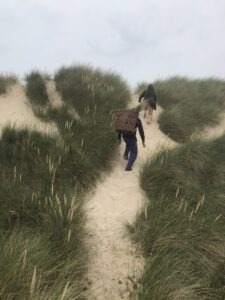

Kim Charnley is senior lecturer in Art History at the Open University in the UK, and author of Sociopolitical Aesthetics: Art, Crisis and Neoliberalism (Bloomsbury, 2021). His work has also been published in Art and the Public Sphere, Art Journal, The Large Glas, FIELD: Journal for Socially Engaged Art and Historical Materialism. He is an art theorist and art historian who researches contemporary art, especially socially-engaged art, social practice, art activism and institutional critique. His research has focused especially on the way that collectivity functions as a way of working, and as an ideal, in art that intends to instigate social and political action.
Isabel Lima is a UK-based independent artist and researcher whose practice explores the intersections of identity, culture, and place. Drawing on her own family history of displacement, Lima investigates how artistic collaboration can serve as a tool for enacting citizenship and claiming rights in solidarity with others. Her work centres on long-term, artist-led projects developed in close collaboration with communities who have been systematically impacted by capitalism, colonialism, and structural injustice.
Notes
[1] These rights are named in European Convention of Human Rights (ECHR), Article 10 and Article 11
[2] The arms export licensing data is incomplete because since 2023 the UK government stores roughly 15% of export data in a parallel system, LITE, which is not public. The data mentioned here is publicly searchable through SPIRE database.
[3] For example: Greg Sholette, Delirium and Resistance (Pluto press, 2017); Kuba Szreder, The ABC of the Projectariat (Manchester University Press, 2021).
[4] John Roberts ‘Socially Engaged Art, Direct Democracy, and Artistic Autonomy’ ArtMargins 14:1, pp.7.8.
[5] For Kester’s recent reflections on the implications of this term see: Emanuele Rinaldo Meschini ‘Transforming the Self and the Social: An interview with Grant Kester’ piano b. Arti e Culture Visive vol 9 no.1 15_Meschini_ENG.pdf
[6] Dana Olãrescu ‘Abundant Futures: Building Equity in a Divided World,’ Create News 36, p.3. Create National Development Agency for Collaborative Arts, Ireland: Create-News-36-Screen.pdf
[7] Dana Olãrescu ‘Abundant Futures’ pp.4-8.
[8] Olãrescu ‘Abundant Futures’, p. 7.

